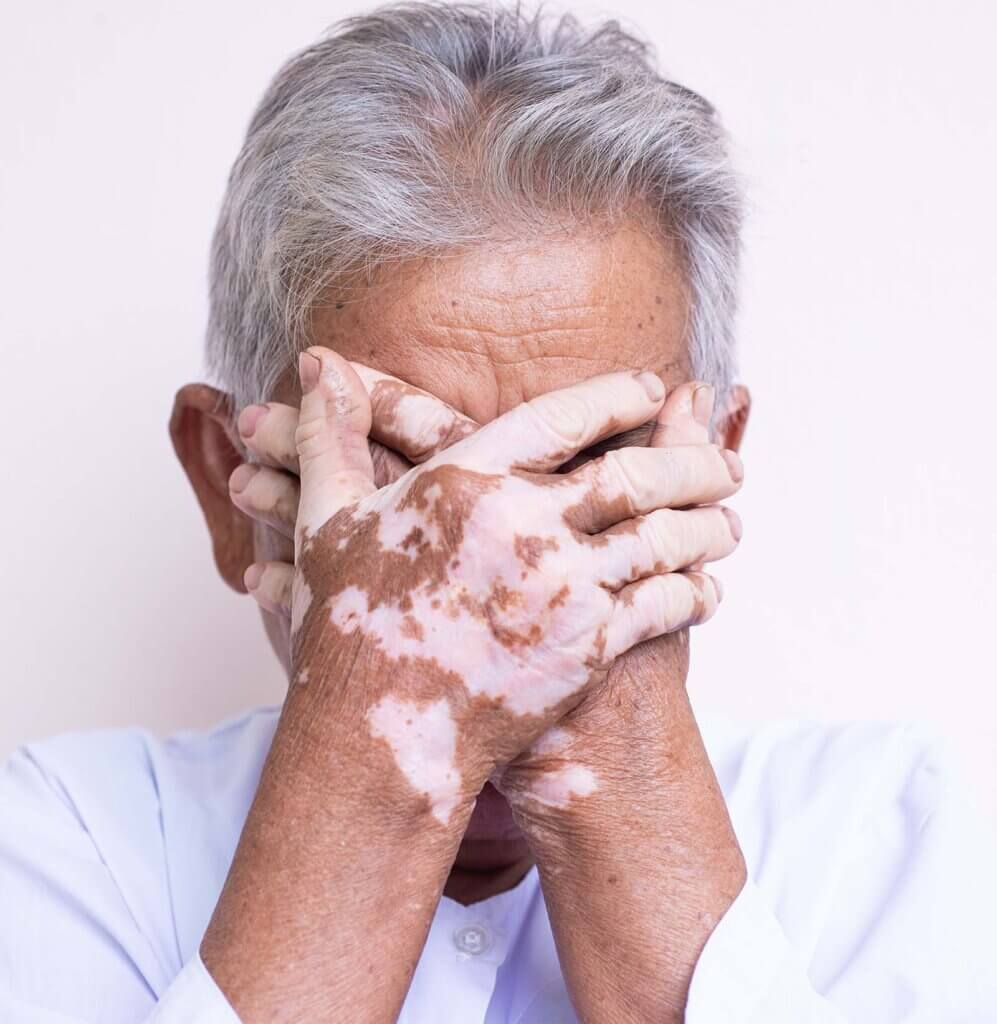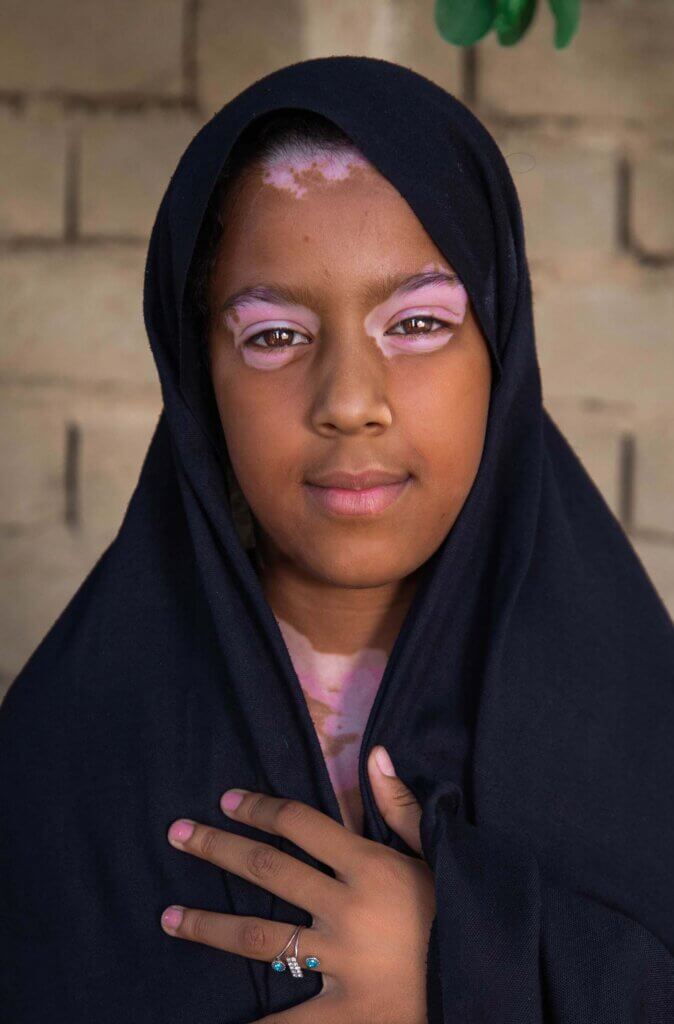Vitiligo Communiqué IV
- ASX: CUV
- Frankfurt Börse: UR9
- Level 1: CLVLY
Introduction
Although our recognition of vitiligo dates to the ancient Vedic and Egyptian texts of 1500 BC, it remains one of the most difficult dermatological conditions to treat. The reasons for its elusory nature are manifold, however, a common theme emerges as mischaracterisation of disease. The very word vitiligo, derived from the Latin vitulum for “small blemish” encapsulates vitiligo’s inherent misnomer. It is even believed that the 16th century physician who coined the term, Hieronymus Mercurialis, was in fact referencing another skin disease at the time of his definition.
In Vitiligo Communiqué I & Vitiligo Communiqué II essential information and principles on the pathogenesis of vitiligo were discussed. In Vitiligo Communiqué III, we shared the current understanding of the psychological impact of vitiligo on patients. In this Vitiligo Communiqué IV, we shall expand on the long-term consequences, both physical and psychological, of vitiligo on patients, with a focus on phototypes IV–VI, and attempt to dispel some of the mischaracterisations surrounding vitiligo.
The main limitation of studies analysing the risk of skin cancer in individuals with vitiligo is a comparison bias with controls. In their landmark study, Paradisi et al noted their control group – people attending vascular surgery – was chosen because “presumably have the same reference population as the patients with vitiligo” allowing for “a direct comparison of the risk.”4 However, multiple studies have proven this assumption to be false. As shown within Selçuk et al’s study, the rate of sunscreen use, and tendencies to remain in the shade, were far greater in vitiligo patients than in the general population.6
Paradisi et al were not alone in this assumption. In Ban et al’s systematic review of this topic, they noted of the four studies reviewed “three compared people with vitiligo to people without vitiligo and one compared vitiligo skin to non-vitiligo skin on the same group of patients.”8
Testimonies were shared by individuals with vitiligo as part of the FDA’s 2021 Virtual Public Meeting on Patient-Focused Drug Development for Vitiligo.7 During the meeting, individuals living with vitiligo shared emotional testimony on how their disorder forced them to avoid sun exposure, accentuating how the risks of photodamage are known and ingrained into their lifestyle.
“They suffer from always burning in the sun without the protection of the darkened skin, and they have to slather in sunscreen or stay in the shade. And sometimes even sunscreen doesn’t help to stop getting sunburnt.”
“Some things I can’t do that I want to do is go out into the sun. I want to be able to go on the beach and do all these I did. You know? Travel without any problems and without the sun burning me severely and everything.”
The wealth of testimony provided by individuals with vitiligo during this workshop, as well as evidence provided by Selçuk et al highlights how the lives of those with vitiligo are profoundly different from those of the general population, and therefore direct comparisons (especially regarding photoprotection) are flawed.
Thus, a clear distinction in photoprotection measures exists between individuals with and without vitiligo making comparisons difficult to accomplish. In not accounting for these potential differences, studies assessing the risk of skin cancer in individuals with vitiligo compared to the general population may have a comparison bias, leading one to question the broad applicability of their results.
The wealth of testimony provided by individuals with vitiligo during this workshop, as well as evidence provided by Selçuk et al highlights how the lives of those with vitiligo are profoundly different from those of the general population, and therefore direct comparisons (especially regarding photoprotection) are flawed.
Thus, a clear distinction in photoprotection measures exists between individuals with and without vitiligo making comparisons difficult to accomplish. In not accounting for these potential differences, studies assessing the risk of skin cancer in individuals with vitiligo compared to the general population may have a comparison bias, leading one to question the broad applicability of their results.
The psychosocial impact of vitiligo:
The impact of vitiligo transcends physical symptoms. The psychological effects of vitiligo can be devastating to a patient’s overall health. In viewing vitiligo in terms of depigmentation alone, a false equivalence has thus been drawn not only between photoprotection habits as remarked, but also lifestyle and quality of life.
Porter & Beuf’s 1991 study has shown how individuals with vitiligo can have a stigmatising handicap, erecting barriers to opportunities, stating vitiligo can even cause impairment equalling or exceeding other bodily afflictions.9–10 These findings were reinforced by Ezzedine et al’s 2015 study, noting the unpredictable prognosis of vitiligo can cause fear and insecurity.11
In addition, social stigmas and myths surrounding vitiligo’s cause and pathology exacerbate discrimination further impacting both patient’s mental health and quality of life. As shown by physician Dr. Pearl Grimes, societies place a profound significance on appearance, aesthetics, and pigmentation.12 Any condition that affects appearance may be fraught with loss of privilege, opportunities, and often upward mobility in societies that have a cultural preference for specific skin tones.

“Vitiligo forced me into self-isolation, extreme introversion and at times fully closed me off to the world.”
“For 49 years, healthy person being now, I don’t want to go outside. I don’t want to see my face in the mirror.”
Beyond the psychosocial impact of vitiligo, multiple studies have also shown how the impact of vitiligo in patients of darker phototypes (IV-VI) can lead to a more profound loss of identity. As noted in Porter & Beuf’s research, for people with a lighter skin type, “vitiligo is experienced primarily as an appearance impairment… turning white may have severe implications for black identity”. In their systematic review of the topic, Ezzedine et al noted that a significantly higher psychological burden of disease was seen in individuals with Fitzpatrick phototype IV-VI across five separate studies.13 The cause of this exacerbated burden was often linked to the concept of identity loss. This concept was discussed in detail during the FDA workshop with multiple patients referencing how their loss of identity due to vitiligo was the greatest factor impacting their quality of life.
It is clear from the testimony provided by individuals with vitiligo that the psychosocial impact of the disorder can translate to changes to not only their quality of life but a way of life. Vitiligo can severely handicap patients, causing anxiety, depression and fear which can, in turn, lead many to take extreme measures to avoid further progression. In assessing outcomes for vitiligo patients and drawing comparisons between patient groups, it is therefore vital these considerations are contemplated.

“Family and friends tell you “it’s not that bad” and “we still love you” but no one understands the pain of not recognizing yourself in the mirror anymore. I wonder if there will ever be a day that I don’t wake up and do a full body scan looking for new spots.”
“They think it’s cosmetic, but it’s more for me. I am a lifelong coloured person. I feel like I lost my identity. I’m sorry. It’s very difficult to not be so emotional.”
Concluding remarks
As this Communiqué has shown, the effects of vitiligo are far more than skin deep. A diagnosis of vitiligo can have a profound physical, social, and psychological impact on a patient. Despite significant advances, our knowledge of vitiligo remains limited, and several aspects of the disease remain unclear.
Although all studies that attempt to provide us with a greater understanding of vitiligo should be encouraged, it is essential that vitiligo is not mischaracterised in the process. Assumptions that vitiligo is comparable to the general population, as made by Paradisi et al, or other dermatological conditions as noted by Jorgensen et al, has limitations.3 Vitiligo must instead be viewed through the lens of the patient, where the dual physical and emotional impact of the disease may be seen.
At CLINUVEL, our attention is paid to the psychological impact of vitiligo. We focus on specific cases of vitiligo, whereby lesions affecting more prominent visible areas such as the head and neck, and more sensitive areas, such as the genitalia, are understood to have a more severe impact on patients’ self-esteem and quality of life.
This consideration determined the development of our pilot study CUV104, where for the first time, the response to SCENESSE® (afamelanotide 16mg) as a monotherapy will be assessed in patients with darker skin complexions where the loss of pigmentation causes significant physical and psychological distress.14
Conference Calendar:
As discussed in Vitiligo Communiqué III, each Vitiligo Communiqué will now feature a global conference calendar where vitiligo will be a focal point of presentations and discussions. Conferences scheduled thus far for 2022 are outlined below.
| Date | Location | Conference |
|---|---|---|
| 17 Mar ’22 | Boston, USA | Global Vitiligo Foundation Annual Scientific Symposium |
| 24 Mar ’22 | Boston, USA | American Academy of Dermatology (AAD) Annual Meeting |
| 24 Mar ’22 | Boston, USA | USA Annual Skin of Color Society Symposium |
| 24 Mar ’22 | Boston, USA | 31st Annual Meeting of the Photodermatology Society |
| May ’22 | Portland, USA | Annual Society of Investigative Dermatology (SID) Meeting |
| 12 May ’22 | Ljubljana, Slovenia | European Academy of Dermatology and Venereology Symposium |
| 18 May ’22 | Osaka, Japan | 24th World Dermatology and Aesthetic Congress |
| 7 July ’22 | Glasgow, Scotland | 102nd Annual Meeting of the British Association of Dermatologists |
References
1. Weng, Yu-Ching, et al. “Reduced risk of skin cancer and internal malignancies in vitiligo patients: a retrospective population-based cohort study in Taiwan.” Scientific reports 11.1 (2021): 1–9.
2. Schallreuter, Karin U., Desmond J. Tobin, and Angela Panske. “Decreased photodamage and low incidence of non-melanoma skin cancer in 136 sun-exposed Caucasian patients with vitiligo.” Dermatology 204.3 (2002): 194–201.
3. Jørgensen, Mads Gustaf, et al. “Risk of skin cancer in patients with vitiligo in Denmark: A nationwide cohort study.” JAAD International 1.1 (2020): 31–38.
4. Paradisi, Andrea, et al. “Markedly reduced incidence of melanoma and nonmelanoma skin cancer in a nonconcurrent cohort of 10,040 atients with vitiligo.” Journal of the American Academy of Dermatology 71.6 (2014): 1110–1116.
5. Rodrigues, Michelle. “Skin cancer risk (nonmelanoma skin cancers/melanoma) in vitiligo patients.” Dermatologic clinics 35.2 (2017): 129–134.
6. Selçuk, Leyla Baykal, et al. “Sun-protection habits and knowledge of patients with vitiligo.” Acta dermatovenerologica Alpina, Pannonica, et Adriatica 29.1 (2020): 7–10.
7. Food and Drug Administration. “Public Meeting on Patient-Focused Drug Development for Vitiligo” (March 8 2021): https://www.fda.gov/drugs/news-events-human-drugs/public-meeting-patientfocused-drug-development-vitiligo-03082021-03082021
8. Ban, Lu, et al. “Risk of skin cancer in people with vitiligo: a systematic review and meta-analysis.” British Journal of Dermatology 179.4 (2018).
9. Porter, Judith, et al. “Personal responses of patients to vitiligo: the importance of the patient-physician interaction.” Archives of dermatology 114.9 (1978): 1384–1385.
10. Porter, Judith R., and Ann Hill Beuf. “Racial variation in reaction to physical stigma: a study of degree of disturbance by vitiligo among black and white patients.” Journal of Health and Social Behavior (1991): 192–204.
11. Ezzedine K, Eleftheriadou V, Whitton M, van Geel N. Vitiligo. Lancet. 2015 Jul 4;386(9988):74-84. doi: 10.1016/S0140-6736(14)60763–7. Epub 2015 Jan 15. PMID: 25596811.
12. Grimes P. Aesthetics and cosmetic surgery for darker skin types. Lippincott; New York City: 2008. Beauty: A historical and societal perspective; pp. 3–14.
13. Ezzedine, Khaled, et al. “Psychosocial Effects of Vitiligo: A Systematic Literature Review.” American journal of clinical dermatology 22.6 (2021): 757–774.
14. SCENESSE® (afamelanotide 16mg) is approved in the European Union and Australia as an orphan medicinal product for the prevention of phototoxicity in adult patients with erythropoietic protoporphyria (EPP). SCENESSE® is approved in the USA to increase “pain-free” light exposure in adult EPP patients with a history of phototoxicity. Information on the product can be found on CLINUVEL’s website at www.clinuvel.com.
Vitiligo Communiqué Library
The Vitiligo Communiqués provide an in-depth look at the work we conduct and the rationale for developing melanocortins.